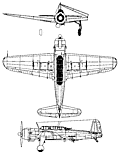|
| At a time when the triumphs of the B5N
were still almost three years in the future,
the Japanese navy issued a specification
for a replacement, recognizing
that only limited overall design improvement
of the B5N could be
achieved in the B5N2. Accordingly design
went ahead in 1939 of the Nakajima
B6N and, despite the navy's preference
for the Mitsubishsi Kasei radial,
a Nakajima Mamoru was selected
for the prototype which flew early in
1941. Superficially the B6N Tenzan
(heavenly mountain) resembled the
earlier aircraft, but the much increased
power and torque of the big
engine and four-blade propeller was
found to impose considerable directional
stability problems, demanding
that the vertical tail surfaces be offset
to one side. Flight trials dragged on,
and were further delayed by troubles
during carrier acceptance tests; then
Nakajima was ordered to stop production
of the Mamoru engine, so modifications
had to be introduced to suit
installation of the Kasei. In due course
B6N1 aircraft (of which only 133 were
built) were embarked in the carriers
Shokaku, Taiho, Hiyo, Junyo and Zuikaku,
and took part in the great Battle of
the Philippine Sea of June 1943, many
being lost when the three first-named
carriers were sunk. In that month production
started of the slightly improved
B6N2 (of which 1,133 were produced
before the end of the war), but
the heavy losses among Japanese carriers
resulted in the 'Jill' being largely
deployed ashore, particularly after the
Battle of Leyte Gulf. Thereafter many
BSNs were consigned to the kamikaze
role.

| MODEL | B6N2 |
| CREW | 3 |
| ENGINE | 1 x Mitsubishi MK4T "Kasei-25",1380 |
| WEIGHTS |
| Take-off weight | 5650 kg | 12456 lb |
| Empty weight | 3010 kg | 6636 lb |
| DIMENSIONS |
| Wingspan | 14.9 m | 49 ft 11 in |
| Length | 10.87 m | 36 ft 8 in |
| Height | 3.8 m | 12 ft 6 in |
| Wing area | 37.2 m2 | 400.42 sq ft |
| PERFORMANCE |
| Max. speed | 480 km/h | 298 mph |
| Ceiling | 9040 m | 29650 ft |
| Range w/max.fuel | 3045 km | 1892 miles |
| ARMAMENT | 2 x 7.7mm machine-guns, 800kg of bombs |
 | A three-view drawing (752 x 963) |
| Klaatu83, e-mail, 22.06.2013 01:42 Although this successor to the earlier B5N (Kate) was a marked improvement, it's excellent performance was still achieved at the expense of armor protection for the fuel and crew, as well as at the expense of defensive armament. The performance figures for the B6N were superior to those of the Grumman TBF /TBM Avenger, but the latter was a far more combat-worthy airplane, affording it's crews a much better chance of survival. reply |
| dashanya, 20.06.2011 06:32 and much heavier- more suited to Kamikaze use. The Zekes were a fighter and light - not suited to destroying carriers; Japans main objective reply | | Klaatu83, e-mail, 04.03.2011 21:37 Not quite as good as it's U.S. contemporary, the Grumman Avenger, but far superior to the Albacores and Barracudas that the British were using at that time. reply | | IVAN ALMIRANTE FUERZA IMPERIAL, e-mail, 17.12.2010 06:00 EL TENZAN ES EL MEJOR AVION DE EL IMPERIO JAPONES reply | |
| | AL, e-mail, 25.11.2010 19:02 The survivor at the Paul Garber facility ought to be restored. It was displayed complete at Willow Grove for many years. reply | | John Reed, e-mail, 14.08.2010 23:13 Later versions with the new engine were used exclusively as Naval Torpedo bombers. Late in the war, used along with Kugisho D4Y1-c's JUDYs as Kamikaze aircraft when Zeros ZEKEs had run into short supply. Female names are Bombers, and much heavier- more suited to Kamikaze use. The Zekes were a fighter and light - not suited to destroying carriers; Japans main objective. reply | | Diego José, e-mail, 26.06.2007 17:31 Olá, eu queria construir um aeromodelo B6N Nakajima em escala, será que os Senhores poderiam disponibilizar a planta deste avião ?
Desde já agradeço. reply |
|
Do you have any comments?
|
| 
COMPANY
PROFILE
All the World's Rotorcraft
|









20
reply